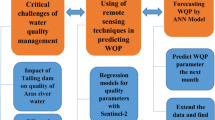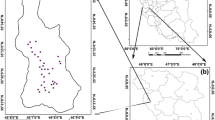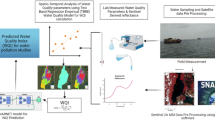Abstract
Using low-cost and fast technology with high accuracy to study the quality of surface water resources is one of the important goals in remote sensing studies. The main purpose of this research was to relate the Sentinel -2 A satellite images, 11 water quality parameters and a suitable model for the study area of Karun and Dez River. In this study, the Sentinel-2 satellite data were used to evaluate its capability for monitoring the quality of surface water. Also, the ground-based samples were collected from water quality sampling stations located on the Karun and Dez rivers at the same time as Sentinel-2 satellite images, and 11 water quality parameters of these samples were analyzed. After pre-processing of the used satellite images, the appropriate spectral bands and indicators were extracted by using sensitivity analysis. ANN and ANFIS neural networks were used to model the quality of water resources. In both models, remote sensing data were introduced as inputs and ground-based data as outputs. Accuracy of the modeling was estimated by calculation of the relative error and RMSE comparing the actual values and the values obtained from the modeling process. Finally, the zoning map of each water quality parameter for the Karun River was prepared using models with higher accuracy. The results of this research indicated a proper accuracy for estimating water quality parameters. According to numeral results, relative error of estimated parameters was varied from 0.049 for the concentration of Potassium (K) to with 0.152 for the concentration of Chlorine (Cl). On the other hand, ANN and ANFIS Model has shown different efficiencies regarding different parameters. The results of this study showed that ANN model performed modeling process with higher accuracy for Mg, HCO3, pH, EC, Turbidity, TDS and K parameters, and ANFIS model for Ca, Na, Cl, SO4 parameters. To be more precise, ANN model accounted for the highest modeling accuracy for K parameter and lowest accuracy for Ca. In contrast, ANFIS model formed the highest modeling accuracy for the SO4 and the lowest accuracy for the EC parameter. The results of this research indicated a capability of the remote sensing for monitoring quality of surface water resources.








Similar content being viewed by others
Explore related subjects
Discover the latest articles, news and stories from top researchers in related subjects.References
Abdelmalik KW (2018) Role of statistical remote sensing for inland water quality parameters prediction. Egyptian J Remote Sensing Space Sci 21:193–200
Alizadeh MJ, Kavianpoura MR, Danesh M, Adolf J, Shamshirband SH, Chau K-W (2018) Effect of river flow on the quality of estuarine and coastal waters using machine learning models. Eng Appl Comput Fluid Mech 12(1):810–823
Alves MM, Pirmez L, Rossetto S, Delicato FC, de Farias CM, Pires PF, Zomaya AY (2017) Damage prediction for wind turbines using wireless sensor and actuator networks. J Netw Comput Appl 80:123–140
Avdan ZY, Kaplan G, Goncu S, Avdan U (2019) Monitoring the water quality of small water bodies using high resolution remote sensing data. Int J Geo-Info 8, 553:1–12
Bagherian MM, Akhoundali AM, Moazed H, Jaafarzadeh N, Ahadian J, Hasoonizadeh H (2014) Evaluation of Karun river water quality scenarios using simulation model results. pp. 339–358
Baillarin S, Meygret A, Dechoz C, Petrucci B, Lacherade S, Tremas T, Spoto F (2012) Sentinel-2 level 1 products and image processing performances. Paper presented at the Geoscience and Remote Sensing Symposium (IGARSS), 2012 IEEE International
Barrett DC, Frazier AE (2016) Automated method for monitoring water quality using Landsat imagery. Water 8(6):257
Bonansea M, Rodriguez MC, Pinotti L, Ferrero S (2015) Using multi-temporal Landsat imagery and linear mixed models for assessing water quality parameters in río Tercero reservoir (Argentina). Remote Sens Environ 158:28–41
Bui DT, Pradhan B, Nampak H, Bui Q-T, Tran Q-A, Nguyen Q-P (2016) Hybrid artificial intelligence approach based on neural fuzzy inference model and metaheuristic optimization for flood susceptibility modeling in a high-frequency tropical cyclone area using gis. J Hydrol 540:317–330
Chen X-Y, Chau K-W (2019) Uncertainty analysis on hybrid double feed forward neural network model for sediment load estimation with LUBE method. Water Resour Manag 33(10):3563–3577
Chen K, Guo S, Lin Y, Ying Z (2010) Least absolute relative error estimation. J Am Stat Assoc 105(491):1104–1112
Elhag M, Gitas IZ, Othman A, Bahrawi J (2019) Effect of water surface area on the remotely sensed water quality parameters of Baysh dam lake, Saudi Arabia. Hydrol Earth Syst Sci Discus 308:1–20
ESA5. (2016) Sentinel-2-msi user guides (product types)
ESA6. (2016) Science toolbox exploitation platform (sen2cor). Retrieved from http://step.esa.int/main/third-party-plugins-2/sen2cor
Feyisa GL, Meilby H, Fensholt R, Proud SR (2014) Automated water extraction index: a new technique for surface water mapping using Landsat imagery. Remote Sens Environ 140:23–35
Guo Q, Wu X, Bing Q, Pan Y, Wang Z, Fu Y, Liu J (2016) Study on retrieval of chlorophyll-a concentration based on Landsat OLI imagery in the Haihe River, China. Sustainability 8(8):758
Hanqiu X (2006) Modification of normalised difference water index (NDWI) to enhance open water features in remotely sensed imagery. Int J Remote Sens 27(14):3025–3033
https://scihub.copernicus.eu/dhus/#/home (Copernicus Open Access Hub)
Iran I. o. S. a. I. R. o (2011) Features of drinking water. In (Vol. 1053 pp. 25). Iran: Institute of Standards and Industrial Research of Iran (Persian)
Islamic Republic of Iran Vice Presidency For Strategic Planning and Supervision (2011) Instruction for surface water quality monitoring, vol 522. Ministry of Energy (Persian), Iran, pp 222
Jachner S, Van den Boogaart G, Petzoldt T (2007) Statistical methods for the qualitative assessment of dynamic models with time delay (r package qualv). J Stat Softw 22(8):1–30
Jang JSR (1993) ANFIS: adaptive network-based fuzzy inference system. IEEE Trans Syst Man Cybernet 23(3):665–685
Kargar K, Samadianfard S, Parsa J, Nabipour N, Shamshirband SH, Mosavi A, Chau K-W (2020) Estimating longitudinal dispersion coefficient in natural streams using empirical models and machine learning algorithms. Eng Appl Comput Fluid Mech 14(1):311–322
Keshavarzi A, Sarmadian F, Shiri J, Iqbal M, Tirado-Corbalá R, Omran E-SE (2017) Application of ANFIS-based subtractive clustering algorithm in soil cation exchange capacity estimation using soil and remotely sensed data. Measurement 95:173–180
Kurtulus B, Flipo N, Goblet P (2010) Sensitivity analysis on an adaptive neuro fuzzy inference system (ANFIS) for hydraulic head interpolation: The orgeval experimental site/France. Paper presented at the XVIII International Conference on Water Resources CMWR
Laili N, Arafah F, Jaelani L, Subehi L, Pamungkas A, Koenhardono E, Sulisetyono A (2015) Development of water quality parameter retrieval algorithms for estimating total suspended solids and chlorophyll-a concentration using Landsat-8 imagery at Poteran island water. ISPRS Ann Photogrammetry Remote Sensing Spatial Info Sci 2(2):55
Liu J, Zhang Y, Yuan D, Song X (2015) Empirical estimation of total nitrogen and total phosphorus concentration of urban water bodies in China using high resolution Ikonos multispectral imagery. Water 7(11):6551–6573
Main-Knorn M, Pflug B, Debaecker V, Louis J (2015) Calibration and validation plan for the l2a processor and products of the sentinel-2 mission. Int Arch Photogrammetry Remote Sensing Spatial Info Sci 40(7):1249
Muller-Wilm U, Louis J, Richter R, Gascon F, Niezette M (2013) Sentinel-2 level 2a prototype processor: Architecture, algorithms and first results. Paper presented at the Proceedings of the 2013 ESA Living Planet Symposium, Edinburgh, UK
Mustaffa Z, Yusof Y (2011) A comparison of normalization techniques in predicting dengue outbreak. Paper presented at the International Conference on Business and Economics Research
Pyo J, Pachepsky Y, Baek S-S, Kwon Y, Kim M, Lee H, Nam G (2017) Optimizing semi-analytical algorithms for estimating chlorophyll-a and phycocyanin concentrations in inland waters in Korea. Remote Sens 9(6):542
Rangzan K, Kabolizadeh M, Karimi D (2020) Improved water quality mapping based on cross-fusion of Sentinel-2 and Landsat-8 imageries. IET Image Process 14(7):1382–1392
Sahu M, Mahapatra SS, Sahu HB, Patel RK (2011) Prediction of water quality index using neuro fuzzy inference system. Water Qual Expo Health 3(3–4):175–191
Shamshirband SH, Nodoushan EJ, Adolf JE, Manaf AA, Mosavi A, Chau K-W (2019) Ensemble models with uncertainty analysis for multi-day ahead forecasting of chlorophyll a concentration in coastal waters. Eng Appl Comput Fluid Mech 13(1):91–101
Sherfey JS, Soplata AE, Ardid S, Roberts EA, Stanley DA, Pittman-Polletta BR, Kopell NJ (2018) DynaSim: a MATLAB toolbox for neural modeling and simulation. Front Neuro Info 12:10
Su T-C, Chou H-T (2015) Application of multispectral sensors carried on unmanned aerial vehicle (UAV) to trophic state mapping of small reservoirs: a case study of Tain-pu reservoir in Kinmen. Taiwan Remote Sensing 7(8):10078–10097
Talebizadeh M, Moridnejad A (2011) Uncertainty analysis for the forecast of lake level fluctuations using ensembles of ANN and ANFIS models. Expert Syst Appl 38(4):4126–4135
Tiyasha, Tung TM, Yaseen ZM (2020) A survey on river water quality modelling using artificial intelligence models: 2000–2020. J Hydrol 585:124670
Toming K, Kutser T, Laas A, Sepp M, Paavel B, Nõges T (2016) First experiences in mapping lake water quality parameters with sentinel-2-msi imagery. Remote Sens 8(8):640
Uysal G, Şensoy A, Şorman AA (2016) Improving daily streamflow forecasts in mountainous upper euphrates basin by multi-layer perceptron model with satellite snow products. J Hydrol 543:630–650
Wang L, Kisi O, Zounemat-Kermani M, Li H (2017) Pan evaporation modeling using six different heuristic computing methods in different climates of China. J Hydrol 544:407–427
Xie T, Yu H, Wilamowski B (2011) Comparison between traditional neural networks and radial basis function networks. IEEE Int Symp Ind Electron:1194–1199
Yan H, Zou Z, Wang H (2010) Adaptive neuro fuzzy inference system for classification of water quality status. J Environ Sci 22(12):1891–1896
Zhou Y (2020) Real-time probabilistic forecasting of river water quality under data missing situation: deep learning plus post-processing techniques. J Hydrol 589:125164
Zhou G, Ma Z, Sathyendranath S, Platt T, Jiang C, Sun K (2018) Canopy reflectance modeling of aquatic vegetation for algorithm development: global sensitivity analysis. Remote Sens 10(6):837
Zolfaghari K, Duguay CR (2016) Estimation of water quality parameters in Lake Erie from Meris using linear mixed effect models. Remote Sens 8(6):473
Acknowledgments
We are grateful to the Research Council of Shahid Chamran University of Ahvaz for financial support (SCU.EG98.26151).
Author information
Authors and Affiliations
Corresponding author
Additional information
Communicated by: H. Babaie
Publisher’s note
Springer Nature remains neutral with regard to jurisdictional claims in published maps and institutional affiliations.
Rights and permissions
About this article
Cite this article
Kabolizadeh, M., Rangzan, K., Zareie, S. et al. Evaluating quality of surface water resources by ANN and ANFIS networks using Sentinel-2 satellite data. Earth Sci Inform 15, 523–540 (2022). https://doi.org/10.1007/s12145-021-00741-z
Received:
Accepted:
Published:
Issue Date:
DOI: https://doi.org/10.1007/s12145-021-00741-z




